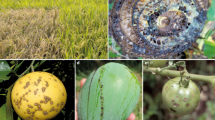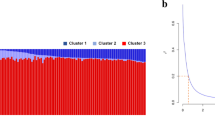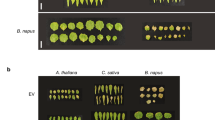Abstract
Pathogens face a hostile and often novel environment when infecting a new host, and adaptation is likely to be an important determinant of the success in colonization and establishment. We hypothesized that resistant hosts will impose stronger selection on pathogens than susceptible hosts, which should accelerate pathogen evolution through selection biased toward effector genes. To test this hypothesis, we conducted an experimental evolution study on Xanthomonas citri subsp. citri (Xcc) in a susceptible plant species and a resistant plant species. We performed 55 rounds of repeated reinoculation of Xcc through susceptible host grapefruit (isolates G1, G2, G3) and resistant host kumquat (isolates K1, K2, K3). Consequently, only K1 and K3 isolates lost their ability to elicit a hypersensitive response (HR) in kumquat. Illumina sequencing of the parental and descendant strains P, G1, G2, G3, K1, K2 and K3 revealed that fixed mutations were biased toward type three secretion system effectors in isolates K1 and K3. Parallel evolution was observed in the K1 and K3 strains, suggesting that the mutations result from selection rather than by random drift. Our results support our hypothesis and suggest that repeated infection of resistant hosts by pathogens should be prevented to avoid selecting for adaptive pathogens.
Similar content being viewed by others
Main
Microbial pathogenicity in animals and plants has evolved through an arms race of attack and defense, reflecting successive developments in virulence and disease resistance (Arnold et al., 2007). Pathogens face a hostile and often novel environment when infecting a new host, and adaptation is likely to be an important determinant of the success in colonization and establishment (Wong et al., 2012). Understanding adaptive processes in pathogens, and in particular, characterizing the various genetic routes to adaptation in novel environments, is important for developing effective control measures.
Plants, unlike mammals, lack dedicated mobile defender cells and a somatic adaptive immune system. The quantitative output of a two-branched innate immune system of plants described through the ‘zig-zag’ model (Jones and Dangl, 2006) explains host specificity in terms of a coevolutionary arms race between the plant and the pathogen. This model proposes distinct phases including pathogen-associated molecular pattern-triggered immunity; effector-triggered susceptibility in overcoming pathogen-associated molecular pattern-triggered immunity; effector-triggered immunity that further protects the plant against microbial infection; and countermove where the pathogen may evolve to escape recognition by either alteration of the binding specificity of the effector or by evolution of novel host-defense suppression (Jones and Dangl, 2006). As the coevolutionary arms race holds a central position in our understanding of pathogen–host interactions, it is important to dissect the molecular basis and dependencies of this process to fully understand the evolutionary forces and the molecular and ecological interactions that drive reciprocal adaptations.
In this study, we hypothesized that resistant hosts will impose a stronger selection than susceptible hosts on pathogens, which should accelerate pathogen evolution through selection biased toward effector genes. Thus, by investigating fixed mutations and the corresponding phenotype, we were able to further understand the molecular mechanism that drives the pathogens to overcome plant defense in resistant varieties. Here, we used a combination of experimental evolution and whole-genome sequencing to investigate pathogen adaptation using Xanthomonas citri subsp. citri (Xcc). Xcc causes citrus canker disease, and has previously been chosen as a model for investigating the molecular determinants of host specialization (Brunings and Gabriel, 2003). Xcc contains typical pathogen-associated molecular patterns (Casabuono et al., 2011) and 25 type three secretion system effectors (da Silva et al., 2002). It is well documented that Meiwa kumquat (Fortunella crassifolia) is immune to Xcc and shows a hypersensitive response (HR) reaction to Xcc infection (Khalaf et al., 2008; Fu et al., 2012), whereas grapefruit (Citrus paradise) is one of the highly susceptible citrus varieties (Gottwald and Graham, 2000). In addition, the HR in kumquat caused by Xcc takes several days to develop. The slow HR of kumquat to Xcc provides a unique opportunity to probe the adaptive evolution of this bacterial pathogen in resistant and susceptible hosts.
To test our hypothesis, we performed 55 rounds of repeated reinoculation (referred to as ‘passaging’) of individual colonies of Xcc strain 306 (parent strain, designated as P) at 106 CFU ml−1 into grapefruit (colonies designated as G1, G2 and G3) and kumquat (colonies designated as K1, K2 and K3) (Supplementary Figure S1). For the two strains, K1 and K3, which were repeatedly reinoculated into kumquat, loss of HR was observed after 47 and 51 passages, respectively, whereas no changes were observed for other strains. The time of occurrence of loss of HR corresponded to a total of 1762 and 1912 generations for strains K1 and K3, respectively. The loss of HR was stable after 55 passages for both the strains (Figure 1). The strain K3 was reduced in its ability to cause canker disease in grapefruit. We observed no significant differences in the population densities of strains G1, G2, G3 and K2 when compared with the P strain in kumquat (Figure 1d). The growth curves of G1, G2, G3, K2 and P strains in kumquat showed a reduction trend after 3 days post inoculation, and the population densities were much lower in kumquat than those in the compatible interaction in grapefruit, fitting a pattern of incompatible interaction (Alfano and Collmer, 1996; Figure 1).
Pathogenicity assay and population dynamics of different strains of X. citri ssp. citri (Xcc) in susceptible (C. paradise, grapefruit) and resistant (F. crassifolia, kumquat) plants. Comparison of citrus canker disease and HR development in the leaves of grapefruit (a) and kumquat (b), respectively, by different Xcc strains. Population dynamics of different Xcc strains in the leaves of grapefruit (c) and kumquat (d). Bacterial cells were inoculated into fully expanded leaves at a concentration of 106 CFU ml−1. Leaves were photographed 14 days after inoculation. F and B represent the front and back sides of the inoculated leaf. To measure population dynamics, bacterial cells were recovered from the inoculated plants at different time points, and the value represents the mean of three different replicates. The experiment was repeated three times with similar results. Mean values and standard deviations are plotted.
Unlike the P strain, the growth curves of strains K1 and K3 in kumquat were similar to the compatible interaction, as suggested previously (Alfano and Collmer, 1996), and did not induce a HR in kumquat (Figure 1). However, the population densities of K1 and K3 were nearly 10-fold lower than those of the other strains (Figure 1d). Our results suggest that K1 and K3 evade the HR of kumquat. K3 had reduced fitness in the susceptible host grapefruit, whereas K1 maintained its fitness in grapefruit (Figure 1). Our results are also in accordance with previous studies reporting that evolutionary adaptation to a novel set of selective conditions often correlates with either reduced or no fitness advantage in an environment to which the population had previously adapted (Elena and Lenski, 2003; Ensminger et al., 2012).
To decipher the fixed mutations of the G1, G2, G3, K1, K2 and K3 strains relative to the P strain, we used Illumina sequencing technology to map genome-wide single-nucleotide polymorphisms, and deletions and insertions. Illumina sequencing has been used to follow the genome evolution of various bacterial pathogens (Brockhurst et al., 2011; Dettman et al., 2012). On an average, we obtained 15.09 million reads per strain with chromosome coverage ranging from 167 to 399 (Supplementary Table S1). High coverage of reads generated by the G2 Illumina resulted in a false-positive rate of only one per 9 200 000 bp.
Although we obtained very high coverage per base position and negligible false-positive rates by Illumina sequencing (Dharia et al., 2010), we confirmed all the non-synonymous and frameshift mutation resulting in amino-acid substitutions by Sanger sequencing (Supplementary Table S2). Thirty-six (97.3%) of the 37 single-nucleotide polymorphisms predicted by Illumina were confirmed by Sanger sequencing (Table 1). Similar results have been previously reported (Dharia et al., 2010; Wong et al., 2012).
Unlike other in vitro bacterial evolution studies (Barrick et al., 2009), differences in the insertion sequence number or location were not observed. Similar results have been reported previously where an experimental evolution approach was used to investigate pathogen adaptation in completely unrelated environments such as mouse macrophage (Ensminger et al., 2012) and cystic fibrosis-like culture conditions in the presence and absence of fluoroquinolone antibiotics (Wong et al., 2012). In addition, unlike some other studies of the pathogen evolution in planta (Pitman et al., 2005; Lovell et al., 2009), our analysis did not detect the complete loss or gain of any gene among the bacterial strains compared with the parent.
We identified a total of 96 mutations across all the Xcc strains. Of these mutations, 5 are predicted to result in frameshifts in the open reading frame, 29 are synonymous mutations, 31 are non-synonymous mutations and 31 are intergenic (Supplementary Tables S3–S8). Mutation rates of all the strains, except for strain K1, were equivalent to those reported from evolution experiments using the whole-genome data (Supplementary Table S9, Wielgoss et al., 2011). Mutation rate for the strain K1 was significantly higher at 529 × 10−11. It must be noted that mutation rates may differ between strains and species, and they may change depending on the environmental conditions experienced by cells (Wielgoss et al., 2011). For strains K1 and K3, the ratio (ω=dN/dS) between the number of amino acid replacing codon changes (non-synonymous changes; N) and synonymous changes (S) is greater than 1, suggesting positive selection (Toft and Andersson, 2010). Previous studies of the genomic basis of adaptation in experimentally evolved bacterial populations have detected an average of 1.07 mutations/100 generations (Dettman et al., 2012). The mutations in strains K1 and K3 are higher than in the other strains used in this study (Supplementary Table S9) and those of previous studies. This difference indicates that Xcc undergoes stronger selection pressure in the resistant kumquat plant than in the susceptible grapefruit plant as hypothesized.
As proposed in the ‘zig-zag’ model, mutations in effectors are likely responsible for escape from the host-defense surveillance. In the K1 and K3 strains, which lost the ability to induce a HR reaction in resistant host, we detected both synonymous and non-synonymous mutations in multiple type three secretion system effectors, such as avrXacE1 (KI and K3, Supplementary Figure S2), pthA2 (K3), avrXacE3 (K3), pthA4 (K1 and K3, Supplementary Figure S3) and XAC3230 (K1); the latter is an XopAI effector and shares a common N-terminus with the effectors XopJ and AvrXccE1 (Stavrinides et al., 2006; White et al., 2009). Importantly, the fixed mutations were biased toward type three secretion system effectors. Among the 28 non-synonymous mutations in K1 and K3, 11 occurred in the type three secretion system effectors. These type three secretion system effectors are widely distributed in Xanthomonas species and are known to elicit the HR reaction in resistant hosts, as well as to participate in virulence and pathogenicity in compatible interactions (Boch and Bonas, 2010).
Parallel evolution was observed in the two strains K1 and K3 that independently evolved to evade the HR in the resistant host kumquat. For K1 and K3, multiple instances of parallel evolution were observed, including non-synonymous mutations in avrXacE1 (Xaca0049), Xac2251, orfT (Xac3229), xpsF (Xac3543) and pthA4 (Xacb0065; Table 1). These results indicate that the mutations in strains K1 and K3 did not evolve by random drift, but by selection. Similar results have been reported in the long-term experimental evolution of Escherichia coli (Barrick et al., 2009), Legionella pneumophila in mouse macrophages (Ensminger et al., 2012) and Pseudomonas aeruginosa in media mimicking the lungs of cystic fibrosis patients (Wong et al., 2012).
In summary, this study elucidates the role of adaptive evolution in the pathogen–host interaction and provides insight into both the evolutionary and functional mechanisms underlying the coevolutionary interactions of hosts and pathogens. We have provided a clearer understanding of the molecular interactions that drive the arms races of host and pathogen. Our results support our hypothesis that bacteria undergo stronger selection pressure in resistant plants than in susceptible plants with the resulting fixed mutation being biases toward effector genes.
References
Alfano JR, Collmer A . (1996). Bacterial pathogens in plants: life up against the wall. Plant Cell 8: 1793–1807.
Arnold DL, Jackson RW, Waterfield NR, Mansfield JW . (2007). Evolution of microbial virulence: the benefits of stress. Trends Genet 23: 293–300.
Barrick JE, Yu SD, Yoon SH, Jeong H, Oh TK, Schneider D et al (2009). Genome evolution and adaptation in a long-term experiment with Escherichia coli. Nature 461: 1243–1247.
Boch J, Bonas U . (2010). Xanthomonas AvrBs3 family-type III effectors: discovery and function. Annu Rev Phytopathol 48: 419–436.
Brockhurst MA, Colegrave N, Rozen DE . (2011). Next-generation sequencing as a tool to study microbial evolution. Mol Ecol 20: 972–980.
Brunings AM, Gabriel DW . (2003). Xanthomonas citri: breaking the surface. Mol Plant Path 4: 141–157.
Casabuono A, Petrocelli S, Ottado J, Orellano EG, Couto AS . (2011). Structural analysis and involvement in plant innate immunity of Xanthomonas axonopodis pv. citri lipopolysaccharide. J Biol Chem 286: 25628–25643.
da Silva AC, Ferro JA, Reinach FC, Farah CS, Furlan LR, Quaggio RB et al (2002). Comparison of the genomes of two Xanthomonas pathogens with differing host specificities. Nature 417: 459–463.
Dettman JR, Rodrigue N, Melnyk AH, Wong A, Bailey SF et al (2012). Evolutionary insight from whole-genome sequencing of experimentally evolved microbes. Mol Ecol 21: 2058–2077.
Dharia NV, Bright AT, Westenburger SJ, Barnes SW, Batalov S et al (2010). Whole-genome sequencing and microarray analysis of ex vivo Plasmodium vivax reveal selective pressure on putative drug resistance genes. Proc Natl Acad Sci USA 107: 20045–20050.
Elena SF, Lenski RE . (2003). Evolution experiments with microorganisms: the dynamics and genetic bases of adaptation. Nat Rev Genet 4: 457–469.
Ensminger AW, Yassin Y, Miron A, Isberg RR . (2012). Experimental evolution of Legionella pneumophila in mouse macrophages leads to strains with altered determinants of environmental survival. PLoS Pathog 8: e1002731.
Fu XZ, Gong XQ, Zhang YX, Wang Y, Liu JH . (2012). Different transcriptional response to Xanthomonas citri subsp. citri between kumquat and sweet orange with contrasting canker tolerance. PLoS One 7: e41790.
Gottwald TR, Graham JH . (2000). Canker. In: Timmer LW, Garnsey SM, Graham JH, (eds.) Compendium of Citrus Diseases 2nd edn, APS Press: St. Paul, MN, USA.
Jones JDG, Dangl JL . (2006). The plant immune system. Nature 444: 323–329.
Khalaf A, Moore GA, Jones JB, Gmitter FG . (2008). New insights into the resistance of Nagami kumquat to canker disease. Physiol Mol Plant Pathol 71: 240–250.
Lovell HC, Mansfield JW, Godfrey SAC, Jackson RW, Hancock JT, Arnold DL . (2009). Bacterial evolution by genomic island transfer occurs via DNA transformation in planta. Curr Biol 19: 1586–1590.
Pitman AR, Jackson RW, Mansfield JW, Kaitell V, Thwaites R, Arnold DL . (2005). Exposure to host resistance mechanisms drives evolution of bacterial virulence in plants. Curr Biol 15: 2230–2235.
Stavrinides J, Ma W, Guttman DS . (2006). Terminal reassortment drives the quantum evolution of type III effectors in bacterial pathogens. PLoS Pathog 2: e104.
Toft C, Andersson SGE . (2010). Evolutionary microbial genomics: insights into bacterial host adaptation. Nat Rev Genet 11: 465–475.
White FF, Potnis N, Jones JB, Koebnik R . (2009). The type III effectors of Xanthomonas. Mol Plant Pathol 10: 749–766.
Wielgoss S, Barrick JE, Tenaillon O, Cruveiller S et al (2011). Mutation rate inferred from synonymous substitutions in a long-term evolution experiment with Escherichia coli. G3 1: 183–186.
Wong A, Rodrigue N, Kassen R . (2012). Genomics of adaptation during experimental evolution of opportunistic pathogen Pseudomonas aeruginosa. PLoS Genet 8: e1002928.
Acknowledgements
This study was supported by the United States Department of Agriculture-Cooperative State Research Education and the Extension Services Special Citrus Canker Grant Project 2011-73402 (NW). We thank Lisa Malyak for critical reading of the manuscript.
Author information
Authors and Affiliations
Corresponding author
Ethics declarations
Competing interests
The authors declare no conflict of interest.
Additional information
Supplementary Information accompanies this paper on The ISME Journal website
Supplementary information
Rights and permissions
About this article
Cite this article
Trivedi, P., Wang, N. Host immune responses accelerate pathogen evolution. ISME J 8, 727–731 (2014). https://doi.org/10.1038/ismej.2013.215
Received:
Revised:
Accepted:
Published:
Issue Date:
DOI: https://doi.org/10.1038/ismej.2013.215
Keywords
This article is cited by
-
Mapping the adaptive landscape of a major agricultural pathogen reveals evolutionary constraints across heterogeneous environments
The ISME Journal (2021)
-
Grapevine rootstocks shape underground bacterial microbiome and networking but not potential functionality
Microbiome (2018)
-
Positive selection is the main driving force for evolution of citrus canker-causing Xanthomonas
The ISME Journal (2015)




